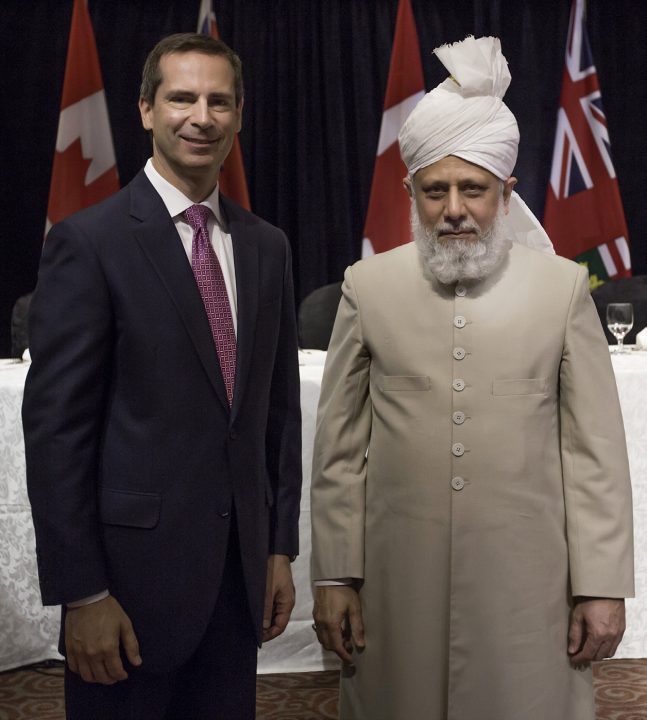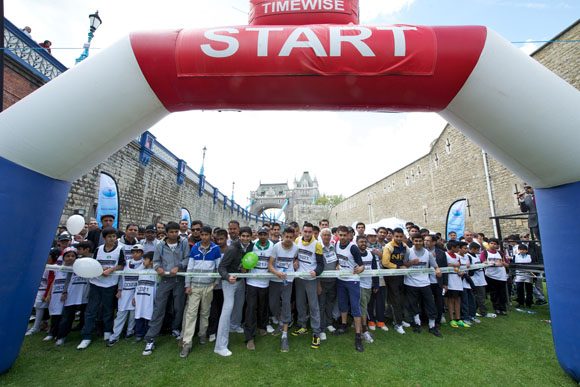Fadl-i-’Umar
One of the first initiatives of Hadhrat Khalifatul Masih III(ru) was an appeal on December 21st, 1965 for the establishment of the Fadl-i-Umar Foundation in memory of the Second Caliph.
The role of the Foundation was not to take over or intervene in the exercise of any function that had been allotted to any of the existing institutions or departments of the Movement, but instead, it could be called upon to render aid or assistance in carrying out any project which the department concerned was unable to put through for lack of adequate personnel or resources.
An appeal was made to the Community to provide two and a half million rupees (equivalent GBP £125,000 at historic exchange rate, £1=20PKR) as the capital of the proposed Foundation, the income of which would be utilised by the Foundation for the achievement of its purposes. The project got off to a flying start and in a short span of time, members contributed Rs. 3.4 million towards the capital of the foundation.
The purpose of the Foundation was to honour the loving memory of the late Hadhrat Mirza Bashir-ud-Din Mahmud Ahmad(ra) by promoting an understanding of the Qur’an through his commentaries; reading his books; speeches on various topics; comprehending the depth of his poetry; reading his biography and viewing his photographs; and, learning about the schemes he launched and the programmes he started.
One of the projects started was for stimulating the intellectual capacities of those members of the Movement who were interested in scholastic pursuits. It was announced that five awards would be made every year to the value of one thousand rupees to each scholar who would prepare and submit to the Foundation a thesis on any of the diverse intellectual topics specified by the Foundation, which in the estimation of the Foundation gave proof of high intellectual endeavour.
With the development of Rabwah as the Headquarter of the Movement, the need of an adequate library became apparent. In 1952, Hadhrat Khalifatul Masih II(ra) directed during the Majlis Mushawarat that his library and the central library of Sadr Anjuman Ahmadiyya into one library. The Sadr Anjuman Ahmadiyya had not been able to make financial provision for the housing of such a library and so the Foundation came forward with the offer that it would undertake the construction of the building and other facilities pertaining to the library on some suitable site to be provided by the Anjuman. The offer of the Foundation was accepted; the foundation stone was laid on 18 January 1970; the building was erected and on completion was handed over to the Sadr Anjuman. On 3 October, 1971 Hadhrat Khalifatul Masih III(ru) inaugurated the new Khilafat Library in Rabwah, which now houses over 100,000 books, rare manuscripts, children’s section, administrative offices and science displays. The Fadl-i-Umar Foundation not only paid for the building but the cost of the furniture and the books.
Guesthouses
With the opening of new Missions of the Community, and the proliferation of its branches across the globe, the number of members in foreign countries visiting Rabwah in all seasons of the year, but more particularly on the occasion of the Annual Conference in the last week in December, had grown. The Tahrik Jadid had built a modest guesthouse simultaneously with the construction of its offices, which was maintained in good condition, but the accommodation provided therein was limited and soon became inadequate for the demands made upon it. Thus the need was felt for a much larger hostel suitable for foreign visitors.
Again the Foundation came forward with the offer to construct such a hostel on the scale and to the specifications that would meet the need that had arisen. This offer was accepted by the Tahrik Jadid. The demand for hostel accommodation of various types had continued to grow and a number of smaller hostels had been constructed at the instance of institutions of the Community other than the Fadl-i-Umar Foundation.
Publications
The Foundation also began publishing the addresses delivered by Hadhrat Khalifatul Masih II(ra): Khutabat-i- Mahmud (sermons of the Second Khalifa(ra). Then in 1981, a book depot selling publications at low cost was opened in Rabwah by Khalifatul Masih III(ru)
Waqf-i-Ardi Scheme
On March 12, 1966 Hadhrat Khalifatul Masih III(ru) introduced the Waqf-i-Ardi project. Waqf-i-Ardi means temporary devotion of one’s time. Participants are required to spend at least two weeks at an assigned place in the country. The purpose of this project is to promote the learning and teaching of the Holy Qur’an as well as imparting religious knowledge to local members.
Inauguration of Mosques
In 1967, Hadhrat Khalifatul Masih III(ru) travelled to Europe, leaving Rabwah on 6 July and returning home on 24 August, 1967. He visited Germany, Switzerland, Holland, Denmark and England. During his visit to England, he took a break in the Lake District and staggered tourists and the local people with his flawless Oxford accent. In Copenhagen, the capital of Denmark, Hadhrat Khalifatul-Masih III(ru) inaugurated the first mosque built entirely by the financial contributions of Ahmadi women.
On 31 March, 1972 Hadhrat Khalifatul Masih III(ru) inaugurated the magnificent al-Aqsa Mosque in Rabwah which can accommodate over 150,000 worshippers. The entire cost of the project, over 600,000 rupees, was borne by an affluent Ahmadi.
In 1976 Hadhrat Khalifatul Masih III(ru) opened a mosque in the Swedish city of Gothenburg.
Initiation of the Nusrat Jahan scheme
On 4 April 1970, Hadhrat Khalifatul Masih III(ru), became the first Khalifa to travel to Africa to make an appraisal of the community and opportunities of further progress.
He visited Nigeria, Ghana, Ivory Coast, Liberia, Gambia and Sierra Leone. During this and subsequent visits, he forged new and long-lasting relations with the Heads of various African countries who beseeched him to pray for their country. His friendship with Mr. Williams V.S. Tubman, Liberia’s longest serving President (1944-1971), Gen. Yakubu Gowon of Nigeria, amongst others was respected by all.
At the end of his visit to those countries of West Africa, he arrived in London and, in an address to the Community in a meeting in which all the branches of the Community in Britain were represented, gave a brief account of the impressions he had gathered in the West African countries that he had visited, and stressed the great need of pressing forward with humantarian services in West Africa.
He announced a scheme that he had conceived under Divine direction, of expanding the activities of the Community in West Africa through the establishment of a substantial number of schools, colleges, clinics and hospitals, which were the great need of the people of West Africa. He mentioned that the programme that he had in mind for the next three years would require an outlay of one hundred thousand pounds sterling and called upon the Community to furnish a substantial portion of that amount as early as possible so that there should be no delay in launching the programme.
As Hadhrat Khalifatul Masih III(ru) later wrote:
‘When I was in The Gambia Allah, the Glorious, inspired me forcefully with the idea that should I invest a hundred thousand pounds in these countries, He would bless it greatly and it would produce great results. I was beside myself with joy. I had some plans and programmes in mind, but now Allah had taken over. I came to London. I explained to friends that Allah, the Glorious, had indicated His Will to me that we should invest the minimum sum of one hundred thousand pounds in the six countries (of Africa that I had toured). I had in my mind the entire scheme detailing heads of expenditure in this behalf and that I wanted in this connection immediately from the Ahmadiyya Community of England, two hundred devotees willing to donate £200 each and another two hundred devotees prepared to contribute £100 each and the rest willing to offer £36 at the rate of one pound per month. I told them that £10,000 should be collected in cash before I started on my return journey. The departure was 12 days away at the time. I was with the members for two hours. I had a one-hour sitting with them on Friday, and another one-hour sitting on Sunday – we had new participants on that day. A total contribution of £28,000 was promised within these two one-hour sessions with £3,000 to £4,000 in ready cash. I arranged under personal supervision a new bank account and named it “Nusrat Jahan Reserve Fund”.(1)’
Volunteers called on all Ahmadi Muslim homes in the UK and in no time, the total amount pledged by the Community for the Nusrat Jahan Scheme, far exceeded the hundred thousand pounds which was the original target. But this was only the financial requirement.
Teachers, physicians and surgeons were needed for the schools and hospitals that were to be set up in West Africa. On 26 June, 1970, for the Leap Forward Scheme, he called upon Ahmadi doctors and teachers to volunteer their services for work in West Africa, and indicated that in case he found that the number of volunteers did not correspond to the need, he would select the teachers and doctors who would be required to proceed to West Africa under his directions. He announced that he had promised the African countries that he had visited to establish a minimum of twenty-five health centres and seventy to eighty schools in those countries.
By the end of 1972, sixteen new hospitals and thirteen new secondary schools had been opened and were in full operation. The success of the medical centres was so remarkable that in many instances they became self-multiplying. In deserving cases relief was administered free, and yet the income from several of the centres not only enabled the needs of suitable buildings and necessary equipment to be met but the surplus helped to establish new health centres in areas where their need was most urgent.
So successful was the Nusrat Jahan Scheme, that it was extended from the initial plan of a three year programme to become a permanent endowment.
The Ahmadiyya Centenary Fund
The first centenary of the foundation of the Ahmadiyya Muslim community was due to be held in March 1989. Hadhrat Khalifatul Masih III(ru) decided to make an announcement concerning the celebration of the centenary of the Movement in the Annual Conference of 1973, in which he enumerated a number of projects including the building of mosques in different parts of the world; the publication of the translations of the Holy Qur’an in French, English, Russian, Italian, Spanish and other languages; publication of the philosophy of the teachings of the Qur’an in suitable brochures in one hundred languages; opening new Missions, the setting up of a large printing press at the Headquarters of the Community, the establishment of a broadcasting station in some country of West Africa where permission for such a station might be forthcoming.
At the Annual Conference of 1973, Hadhrat Khalifatul Masih III(ru) presented the details of a grand project known as the Centenary Jubilee Plan before the members.
The main objectives of the Centenary Jubilee Fund were:
• To spread the message of Islam throughout the world.
• To establish additional Ahmadiyya Mission houses.
• To publish Islamic literature in a hundred languages of the world.
• To install a modern printing press in Pakistan.
• To establish a radio station in an African country.
• To translate the Holy Qur’an into six languages.
Hadhrat Khalifatul Masih III(ru) requested the members to contribute Rs.2.5 million towards this project. The pledges received in this respect were four times the requested amount.
It is worthy of note that the following projects were carried out successfully under the Centenary Jubilee Project:
• Construction of a mosque and mission house in Sweden.
• Construction of a huge mosque and mission house in Srinagar, Kashmir.
• Islamic literature printed on large scale.
• Construction of mosques in Norway and Spain.
• Scholarships and medals given to outstanding students for academic achievements.
• Construction of the Centenary Jubilee office in Rabwah.
In August 1976 Hadhrat Khalifatul Masih III(ru) paid a visit to Ahmadi communities of the United States of America and Canada, making him the first Khalifa to visit the North American continent.
References
1. Hadhrat Khalifatul Masih III(ru); ‘A ‘Message of Peace and a Word of Warning.’ (Address delivered on July 28, 1967, at Wandsworth Town Hall, London, England.




Add Comment